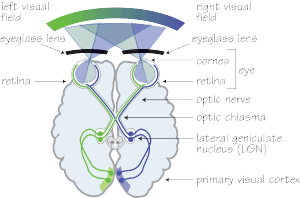Back to: The Human Visual System
OK this will be super brief but we may as well start at the beginning, which is never a bad place to start…
How Do We See?
You are going to hear me say this several more times as you work through the rest of the program:
“We see with our brain, we don’t see with our eyes.”
In fact the retina, the light absorbing lining on the back of the eye, is actually a part of the central nervous system or brain.
“When rays of light strike objects around us, bounce off and enter our visual system we can “see the object.” In fact we can only see reflected light!
Of course that works just fine for anyone without vision problems or what we call a refractive error.
For those with a refractive error, they need eyeglasses. That is where you come in!
The Human Visual System
Take a look at the drawing and notice the eyeglass lens or eyeglasses.
As an optician you will need to know about everything from when a ray of light leaves the sun all the way until it passes through a lens and reaches the cornea. That is what we will cover in the next few lessons.
From the moment the ray strikes the cornea then our bodies visual system (brain) takes over. After that, it all becomes somebody else’s problem! Trust me, you have enough to worry about. Leave the doctor stuff to the doctors.
Here is a great, brief, overview article I found on line:
The Science Of Vision: How Do Our Eyes See?
Jodie Tyley
The Independent (UK newspaper online edition)
Scientists have shown that the structure of the human eye evolved very gradually from a simple light-dark sensor over the course of around 100 million years. It functions in a very similar way to a camera, with an opening through which the light enters, a lens for focusing and a light-sensitive membrane at the back.
The amount of light that enters the eye is controlled by the circular and radial muscles in the iris, which contract and relax to alter the size of the pupil. The light first passes through a tough protective sheet called the cornea, and then moves into the lens. This adjustable structure bends the light, focusing it down to a point on the retina, at the back of the eye.
The retina is covered in millions of light-sensitive receptors known as rods and cones. Each receptor contains pigment molecules, which change shape when they are hit by light, triggering an electrical message that travels to the brain via the optic nerve.
The back of the eye is covered in a layer of light-sensitive cells measuring just fractions of a millimetre in thickness. When photons of light hit the pigments inside the cells, it triggers a cascade of signals, which pass through a series of different connections before they are transmitted to the brain.
First, they move through interneurones and then to neurones known as ganglion cells. These cells are cross-linked, able to compare adjacent signals, filtering out some of the information before passing it on to the brain. This helps to improve contrast and definition. The neurones travel across the back surface toward the optic nerve, which relays the information into the brain.
As the two optic nerves enter the brain, they cross over, coming together at a point known as the optic chiasm. Here, signals from the left side of both eyes are diverted to the left side of the brain, and vice versa, allowing the images from both eyes to be combined and compared.
The signals enter the brain via the thalamus, which separates the incoming information into two parts, one containing colour and detail, and the other movement and contrast. The messages then move to the back of the brain, and into the visual cortex. The cortex is laid out so that it mirrors the back of the retina, allowing a detailed image to be reconstructed.
How colour vision works
Open your eyes, and you are met with an array of different colours, but amazingly you can only detect three different wavelengths of light, corresponding to green, blue, and red. Combining these three signals in the brain creates millions of different shades.
Each eye has between 6 and 7 million cone cells, containing one of three colour-sensitive proteins known as opsins. When photons of light hit the opsins, they change shape, triggering a cascade that produces electrical signals, which in turn transmit the messages to the brain. Well over half of our cone cells respond to red light, around a third to green light, and just two per cent to blue light, giving us vision focused around the yellow-green region of the spectrum.
The vast majority of the cone cells in the human eye are located in the centre of the retina, on a spot known as the fovea, measuring just fractions of a millimetre across. Light is focused on this point, providing a crisp, full-colour image at the centre of our vision. The remainder of the retina is dominated by 120 million rod cells, which detect light, but not colour.
We are so used to seeing the world in red, green and blue that it might seem strange to think that most other animals cannot, but three-coloured vision like our own is relatively unusual. Some species of fish, reptiles and birds have four-colour vision, able to see red, green, blue and ultraviolet or infrared light, but during mammalian evolution, two of the four cone types were lost, leaving most modern mammals with dichromatic vision – seeing in shades of just yellow and blue.
Even today, not all primates can see in three colours; some have dichromatic vision, and many nocturnal monkeys only see in black and white. It is all down to environment; if you don’t need to see all of the colours in order to survive, then why waste energy making the pigments?
Side note: Isaac Newton discovered that no object in the universe has an inherent color attached to it. Rather, all objects reflect and absorb certain frequencies of radiations and those manifests as different colors in the visible spectrum. More about spectrum will be discussed in an upcoming lesson but for the sake of understanding colors, think of an apple. An apple is red because it absorbs all colors but reflects only red. Same for all other observable colors. When you see something white, it means all colors are being reflected and in the case of black, it is all being absorbed by the object. The seven colors in the visible spectrum are violet, indigo, blue, green, yellow, orange and red. Primary colors i.e. red, green and blue can combine to make the rest of the colors. Next time you go to a car showroom, instead of complaining about the unavailability of your preferred color of SUV, be grateful that your retina-brain system can perceive more colors than certain animals like dogs.
Seeing in three dimensions
Our eyes are only able to produce two-dimensional images, but with some clever processing, the brain is able to build these flat pictures into a three-dimensional view. Our eyes are positioned about five centimetres (two inches) apart, so each sees the world from a slightly different angle. The brain compares the two pictures, using the differences to create the illusion of depth.
OK EOTA


